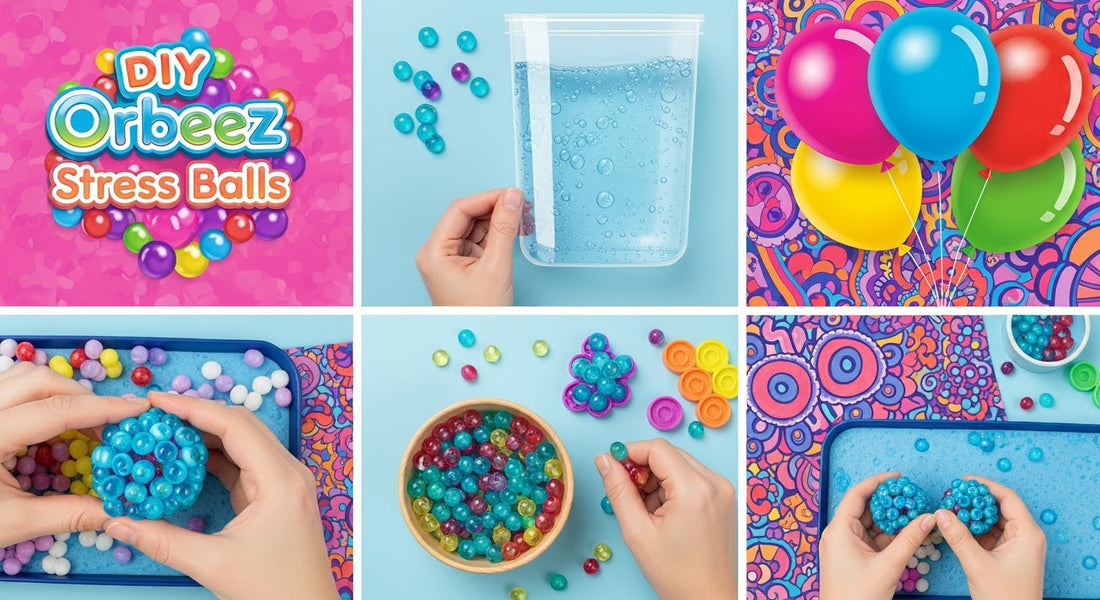
Eco-Friendly Disposal Methods for Orbeez and Water Beads
Share
Orbeez and water beads have become staples in sensory play, home decor, and even gardening. But their superabsorbent polymer (SAP) composition—while making them fun and functional—poses a problem when it’s time to say goodbye. Traditional disposal methods like flushing, trashing wet beads, or dumping them outdoors can clog pipes, pollute waterways, and harm ecosystems. The solution? Eco-friendly disposal that prioritizes the planet without sacrificing convenience. This guide breaks down sustainable ways to dispose of Orbeez and water beads, plus tips to reduce waste and keep these colorful beads out of landfills.
Why Eco-Friendly Disposal Matters for Orbeez
Before diving into methods, it’s crucial to understand the environmental impact of improper Orbeez disposal. SAP beads are designed to resist breakdown, meaning they can linger in the environment for years. Here’s why green disposal is non-negotiable:
-
Waterway Contamination: Even small amounts of Orbeez that slip through drains can end up in rivers, lakes, or oceans. Marine life often mistakes the beads for food, leading to digestive blockages and death.
-
Landfill Buildup: Wet Orbeez in landfills trap moisture, creating ideal conditions for mold growth and methane emissions—a greenhouse gas 25 times more potent than carbon dioxide over 100 years.
-
Soil Degradation: Dumping wet beads in gardens disrupts soil structure, suffocates plant roots, and alters moisture levels, harming native flora and fauna.
5 Eco-Friendly Disposal Methods for Orbeez & Water Beads
These methods prioritize reuse, composting, and responsible waste management, ensuring your Orbeez don’t harm the environment. Choose the one that fits your needs and resources:
1. Compost (For Slow but Natural Breakdown)
Composting is a fantastic way to turn Orbeez into nutrient-rich soil—if done correctly. SAP biodegrades over time in active compost piles, where heat and microorganisms break down the polymer. Here’s how:
-
Dry Thoroughly: Spread wet Orbeez on a baking sheet or cardboard in a single layer. Place in a well-ventilated area for 2–3 days until they shrink back to hard, tiny pellets. Wet beads will mold in compost, so this step is critical.
-
Crush for Speed: Use a rolling pin or mortar and pestle to crush the dried beads into smaller pieces. This increases their surface area, helping microbes decompose them faster.
-
Mix Sparingly: Add ½–1 cup of crushed Orbeez per cubic foot of compost. Pair them with nitrogen-rich materials (fruit peels, grass clippings) and carbon-rich materials (leaves, cardboard) to balance the pile. Avoid large clumps—they’ll take months to break down.
Note: This works best in hot compost piles (130–160°F). If your compost is cold, opt for reuse instead.
2. Reuse as Garden Moisture Retainers
Orbeez make excellent natural water reservoirs for plants. Instead of disposing of them, repurpose them to help your garden thrive while reducing water waste:
-
Prepare the Beads: Dry and crush the Orbeez as in Method 1. For potted plants, keep them slightly larger; for garden beds, crush them finer.
-
Mix with Soil: For potted plants, add 1 part crushed Orbeez to 4 parts potting soil. For garden beds, till the beads into the top 6 inches of soil. When you water, the beads absorb moisture and release it slowly, cutting down on watering frequency by up to 30%.
-
Choose the Right Plants: This works wonders for moisture-loving plants like tomatoes, basil, pothos, and ferns. Avoid succulents—they prefer dry soil.
Bonus: Colored Orbeez add a subtle pop of color to planters, blending functionality with decor.
3. Donate to Educational or Community Groups
One person’s “used” Orbeez is another’s valuable learning tool. Schools, preschools, occupational therapy clinics, and community centers often use water beads for sensory play, science experiments, and art projects. Donating keeps Orbeez out of landfills and supports education:
-
Inspect for Cleanliness: Ensure the Orbeez are free of dirt, mold, or debris. If hydrated, drain and dry them completely.
-
Reach Out: Call or email local schools, daycares, or therapy centers. Many are thrilled to receive free sensory materials.
-
Package Properly: Store dried Orbeez in a labeled, airtight container with care instructions (e.g., “Hydrate with water to expand”).
4. Upcycle into Eco-Friendly Crafts
Unleash your creativity by upcycling Orbeez into sustainable home decor or gifts. This method keeps beads out of waste streams and gives them a new life:
-
Resin Art: Mix dried Orbeez into epoxy resin to create coasters, tray liners, or wall art. The beads add texture and color, making each piece unique.
-
Plant Markers: Insert dried Orbeez into small wooden dowels, then write plant names on them. Stick them in your garden for a colorful, functional touch.
-
Natural Playdough Add-Ins: Mix crushed dried Orbeez into homemade playdough (made with flour, salt, and water) for extra texture. Kids will love the squishy, tactile feel.
5. Dispose via Specialized Waste Programs
If you have a large quantity of Orbeez that can’t be reused or composted, check for local “hard-to-recycle” waste programs. Many cities offer collection days for non-recyclable but non-hazardous materials like SAP beads:
-
Check Local Guidelines: Visit your city’s waste management website or call their hotline. Search for “superabsorbent polymer disposal” or “non-recyclable plastic waste.”
-
Prepare for Drop-Off: Dry the Orbeez completely, then bag them in a clear plastic bag labeled “Orbeez—SAP beads.” Some facilities may require separation from other waste.
Tips to Reduce Orbeez Waste in the First Place
The most eco-friendly disposal is avoiding waste altogether. These tips help you minimize your Orbeez footprint:
-
Hydrate Only What You Need: Orbeez expand 10–15 times their dry size. Start with 1 teaspoon of dry beads for small projects—you can always hydrate more later.
-
Store Unused Beads Properly: Keep hydrated Orbeez in an airtight container with water in the fridge for up to 3 weeks. Dry beads last for years in a cool, dry place.
-
Choose Biodegradable Alternatives: For one-time use, opt for biodegradable water beads made from plant-based materials. They break down in soil in 4–6 weeks.
Common Eco-Friendly Disposal Mistakes to Avoid
Even well-meaning disposal can go wrong. Steer clear of these pitfalls:
-
Composting Wet Orbeez: Wet beads mold in compost, ruining the pile. Always dry them first.
-
Dumping Orbeez in Storm Drains: Storm drains lead directly to waterways—this is just as harmful as flushing.
-
Burning Orbeez: Burning SAP releases toxic fumes that harm air quality and your health.
Conclusion
Eco-friendly disposal of Orbeez and water beads is simple when you know the right methods. Whether you compost, reuse, donate, or upcycle, every choice keeps these beads out of landfills and waterways. By prioritizing sustainability, you not only protect the planet but also set a positive example for kids and your community. Remember: the goal isn’t just to “get rid of” Orbeez—it’s to do so in a way that respects the environment. With these methods, you can enjoy the fun of Orbeez while keeping your carbon footprint small. Let’s turn waste into wonder, one bead at a time.
